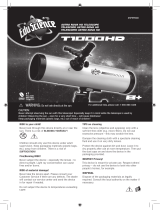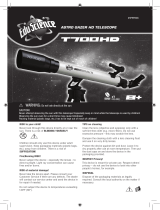Page is loading ...

40mm AZ
Telescope
Manual
Optical design Achromatic refractor
Objective 40mm
Focal Length 400mm
Focuser Rack And Pinion
Tripod Table Top
Eyepieces 6mm and 20mm
Diagional .965
Compass, Software and Star Chart Included
AGE
National Geographic’s net proceeds
support vital exploration, conservation,
research, and education programs.
nationalgeographic.com
Visit our website:

DISPOSAL
Dispose of the packaging materials properly,
according to their type, such as paper or
cardboard. Contact your local waste-disposal
service or environmental authority for
information on the proper disposal.
Please take the current legal regulations into
account when disposing of your device.
Customer Service: Call 1-866-252-3811
WARNING:
Never attempt to observe the sun with this telescope. Make sure children do not attempt to observe the sun with the telescope.
Observing the sun directly, even for a short time, may cause blindness. Packing materials, like plastic bags, should
be kept out of the reach of children.
Risk to your child!
Never look through this device directly at or near the sun. The-
re is a risk of BLINDING YOURSELF!
Children should only use this device under supervision. Keep
packaging materials, like plastic bags and rubber bands, out of
the reach of children, as they pose a choking hazard.
Fire and burn risk!
Never subject the device, especially the lenses, to direct
sunlight. Light ray concentration can cause res and/or burns.
Risk of material damage!
Never take the device apart. Please consult Customer Service
if there are any defects. The dealer will contact our service
center and send the device in for repair if needed.
Do not subject the device to temperatures exceeding 140° F.
Tips on cleaning
Clean the lens (objective and eyepiece) only with a soft,
lint-free cloth, like a microber cloth. Do not use excessive
pressure - this may scratch the lens.
To clean a very dirty lens, dampen the cleaning cloth with
eyeglass cleaning solution, and wipe the lens gently.
Protect the device against dirt and dust. Leave it to dry properly
after use at room temperature. Then put the dust caps on and
store the device in a suitable location.
Respect privacy!
This device is meant for private use. Respect others‘ privacy.
Do not use the device to look into other people‘s homes, or
otherwise inringe on their privacy.
Disposal
Dispose of the packaging material/s as legally required. Con-
sult the local authority on the matter if necessary.
40mm AZ Telescope Manual
National Geographic’s net proceeds
support vital exploration, conservation,
research, and education programs.

Which eyepiece is right?
First of all, it is important that you always choose an
eyepiece with the highest focal width for the beginning
of your observation. Afterwards, you can gradually
move to eyepieces with smaller focal widths. The focal
length is indicated in millimeters, and is written on
each eyepiece. In general, the following is true: The
larger the focal width of an eyepiece, the smaller the
magnication! There is a simple formula for calculating
the magnication:
Focal length of the telescope tube : Focal length of the
eyepiece = magnication
You see: The magnication is also depends on the focal
length of the telescope tube. This telescope contains a
telescope tube with focal length of 360 mm. From this
formula, we see that if you use an eyepiece with a focal
width of 20 mm, you will get the following magnication:
400 mm / 20 mm = 20 x magnication
To make things simpler, I’ve put together a table with
some magnications:
Telescope
tube
focal width
Focal
width of
eyepiece
Magnication
400 mm 20 mm 20x
400 mm 6 mm 67x
Technical data:
• Design: achromatic
• Focal length: 400 mm
• Objective Diameter: 40 mm
All Parts
(Telescope)
1 Focus wheel
2 Diagonal mirror
3 Eyepieces (6 mm, 20 mm)
4 Telescope (Telescope tube)
5 Dew Shield
6 Objective lens
7 Locating screw for the vertical
adjustment
(upward and downward motion)
8 Locating screw for the vertical axis
(for turning to the right and left)
9 Tripod legs
Your
Telescope
Please look for a suitable location for your telescope
before you begin. Use a stable surface e.g. a table.
Mount the Telescope to the Tripod with the locating
screw for the vertical adjustment (7). Insert the eye piece
into the diagonal mirror
(6 mm or 20 mm).
Azimuth mounting
Azimuth mounting just means that you can move your
telescope up and down, left and right, without having to
adjust the tripod.
Use the locating screw for the vertical ne adjustment (7)
and the locating screw for the vertical axis (8) to locate
and lock the position of an object. (to focus an object)
Customer Service: Call 1-866-252-3811
40mm AZ Telescope Manual
1
2
3
5
6 4
7
8
9
National Geographic’s net proceeds
support vital exploration, conservation,
research, and education programs.

Possible objects for observation:
We have compiled and explained a number of very interesting
celestial bodies and star clusters for you but we suggest that
you start practicing during the day focusing on terrestrial objects
such as Birds and or Trees at varying distances from you. On
the accompanying images at the end of the instruction manual,
you can see how objects will appear in good viewing conditions
through your telescope at varying powers (see pictoral examples
below).
Terrestrial Views
Please note the example picture of Mount Rushmore. Start with
the 20 mm eyepiece and focus until clear. After mastering the
focus with the 20 mm change the 6 mm eyepiece and practice
focusing and scanning until images become clear in the eyepiece.
We have included some additional examples that are possible with
your telescope such as a bird and a green on a golf course. DO
NOT POINT YOUR TELESCOPE DIRECTLY AT THE SUN OR
BLINDNESS IS POSSIBLE.
The Moon
The moon is the Earth’s only natural satellite.
Diameter: 3.476 km
Distance: approx. 384 401 km
The moon has been known to humans since prehistoric times. It
is the second brightest object in the sky (after the sun). Because
the moon circles the Earth once per month, the angle between
the Earth, the moon and the sun is constantly changing; one sees
this change in the phases of the moon. The time between two
consecutive new moon phases is about 29.5 days (709 hours).
Orion Nebula (M 42)
M 42 in the Orion constellation
Right ascension: 05:32.9 (Hours: Minutes)
Declination: -05:25 (Degrees: Minutes)
Distance: 1.500 light years
With a distance of about 1500 light years, the Orion Nebula
(Messier 42, abbreviation: M 42) is the brightest diffuse nebula in
the sky – visible with the naked eye, and a rewarding object for
f=20 mm f=6 mm
The Moon
Orion Nebula (M 42)
Ring Nebula in Lyra
constellation (M 57)
Dumbbell Nebula in the
Vulpecula (Fox)
constellation (M 27)
telescopes in all sizes, from the smallest eld glass to the largest
earthbound observatories and the Hubble Space Telescope.
When talking about Orion, we‘re actually referring to the main part
of a much larger cloud of hydrogen gas and dust, which spreads
out with over 10 degrees over the half of the Orion constellation.
The expanse of this enormous cloud stretches several hundred
light years.
Ring Nebula in Lyra constellation (M 57)
M 57 in the Lyra constellation
Right ascension: 18:51.7 (Hours: Minutes)
Declination: -+32:58 (Degrees: Minutes)
Distance: 2.000 light years
The famous Ring Nebula M 57 in the constellation of Lyra is often
viewed as the prototype of a planetary nebula; it is one of the
magnicent features of the Northern Hemisphere’s summer sky.
Recent studies have shown that it is probably comprised of a ring
(torus) of brightly shining material that surrounds the central star
(only visible with larger telescopes), and not of a gas structure
in the form of a sphere or an ellipsis. If you were to look at the
Ring Nebula from the side, it would look like the Dumbbell Nebula
(M27). With this object, we’re looking directly at the pole of the
nebula.
Dumbbell Nebula in the Vulpecula (Fox) constellation (M 27)
M 27 in the Fox constellation
Right ascension: 19:59.6 (Hours: Minutes)
Declination: -+22:43 (Angle: Minutes)
Distance: 1.250 light years
The Dumbbell Nebula (M 27) in Fox was the rst planetary nebula
ever discovered. On July 12, 1764, Charles Messier discovered
this new and fascinating class of objects. We see this object
almost directly from its equatorial plane. If you could see the
Dumbbell Nebula from one of the poles, it would probably reveal
the shape of a ring, and we would see something very similar
to what we know from the Ring Nebula (M 57). In reasonably
good weather, we can see this object well even with small
magnications.
f=20 mm f=6 mm
Terrestrial Images
Customer Service: Call 1-866-252-3811
40mm AZ Telescope Manual
National Geographic’s net proceeds
support vital exploration, conservation,
research, and education programs.

Telescope ABC’s
What do the following terms mean?
Diagonal:
A mirror that deects the ray of light 90 degrees. With a horizontal
telescope tube, this device deects the light upwards so that you
can comfortably observe by looking downwards into the eyepiece.
The image in a diagonal mirror appears upright, but rotated
around its vertical axis (mirror image).
Focal Length:
Everything that magnies an object via an optic (lens) has a
certain focal length (FL). The FL is the length of the path the light
travels from the surface of the lens to its focal point. The focal
point is also referred to as the focus. In focus, the image is clear.
In the case of a telescope, the FL of the telescope tube and the
eyepieces are combined.
Lens:
The lens turns the light which falls on it around in such a way
so that the light gives a clear image in the focal point after it has
traveled a certain distance (focal length).
Eyepiece:
An eyepiece is a system made for your eye and comprised of one
or more lenses. In an eyepiece, the clear image that is generated
in the focal point of a lens is captured and magnied still more.
There is a simple formula for calculating the magnication:
Focal length of the telescope tube / Focal length of the eyepiece =
Magnication
You see: In a telescope, the magnication depends on both the
focal length of the telescope tube and the focal length of the
eyepiece.
Magnication:
The magnication corresponds to the difference between
observation with the naked eye and observation through a
magnication apparatus (e.g. a telescope). In this scheme,
observation with the eye is considered “single”, or 1x
magnication. Accordingly, if a telescope has a magnication
of 30x, then an object viewed through the telescope will appear
30 times larger than it would with the naked eye. See also
“Eyepiece.“
Troubleshooting:
Mistakes: Help:
No picture Remove dust protection cap
and sun-shield from the
objective opening.
Blurred picture Adjust focus using focus ring
No focus possible Wait for temperature to
balance out
Bad picture Never observe through a
glass surface
Viewing object visible Adjust nder
in the nder, but not
through the telescope
Despite using star The star diagonal prism
diagonal prism should be vertical in
the picture is “crooked” the eyepiece connection
DISPOSAL
Dispose of the packaging materials properly,
according to their type (paper, cardboard, etc).
Contact your local waste disposal service or
environmental authority for information on the
proper disposal.
Please take the current legal regulations into
account when disposing of your device. You
can get more information on the proper dis-
posal from your local waste disposal service
or environmental authority.
Customer Service Questions:
1-866-252-3811
Customer Service: Call 1-866-252-3811
40mm AZ Telescope Manual
National Geographic’s net proceeds
support vital exploration, conservation,
research, and education programs.
© 2016 National Geographic Partners LLC. All rights reserved.
NATIONAL GEOGRAPHIC and Yellow Border Design are trademarks of
the National Geographic Society, used under license.
/



